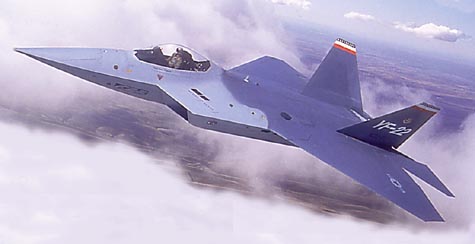

They call it Raptor and it truly is the most fearsome bird in the sky. Its mission is to control the highest ground, the airspace above the battle area. It is a simple but effective strategy. The Air Force boasts that no U.S. ground soldier has been killed by enemy aircraft in more than 40 years, a period that includes the Vietnam War, invasions of Panama and Grenada, and Desert Storm.
Keeping hostile skies all-American has been the job of some noteworthy fighters, including the F-100 Super Sabre and F-4 Phantom. For the past 20 years the U.S. Air Force's alpha wolf has been the twin-engine F-15C Eagle air superiority fighter. Although the Eagle is superb at its work-F-15Cs shot down 32 enemy fighters in air-to-air combat during the Gulf War-foreign-made fighters with equal or superior capabilities are becoming operational, as is a new generation of ultralethal, foreign-made missiles. Thus, the possibility exists that the bad guys could eventually outgun us.
"Americans don't have a God-given right to air dominance," says former Air Force Chief of Staff Gen. Ronald Fogleman. "Somebody's got to invest in it."
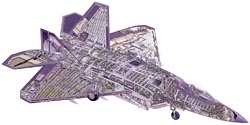
Despite its apparent complexity the F-22 will have fewer parts and be easier to maintain than today's fighters.
With continued, undisputed mastery of the skies in mind, the Air Force began developing a successor for the then-new F-15 back in the mid-1970s. Studies revealed that to dominate airspace in the 21st century, an aircraft would have to be very fast, agile, well-armed, and although the term was still classified, stealthy.
After considering six separate proposals, in 1986 the Air Force issued development contracts for two fighter designs, the YF-22 (above) to be built by Lockheed in partnership with Boeing and General Dynamics, and the YF-23 from Northrop teamed with McDonnell Douglas. The service also ordered competing engines from General Electric and Pratt & Whitney.
The competition to be chosen to build the service's Advanced Tactical Fighter was intense: The winner would receive contracts for up to 750 aircraft worth tens of billions of dollars. The stakes just don't get any higher. By 1990, the two prototypes were dogfighting for their futures in evaluation flights over Edwards Air Force Base in California. In April of the following year the Air Force selected as its winner the Lockheed/Boeing/General Dynamics design, powered by a pair of Pratt & Whitney F119-PW-100 engines. The YF-22 would become the F-22. It would not only be America's 21st century fighter, it would raise the technological bar for all high-performance aircraft to follow.
Continued flight and wind-tunnel testing resulted in refinements to the design, and in December 1993 parts fabrication began for the first flying F-22. The division of work had Boeing handling software and avionics integration and building the aft fuselage and wings. Lockheed's Fort Worth division, which it acquired from General Dynamics in 1993, was responsible for the midfuselage and armament. And what was then Lockheed-Marietta, and is now Lockheed Martin, was charged with building the forward fuselage, vertical fins and stabilators, and landing gear, and doing the final assembly.
On April 9, 1997, with flags aflutter, congressmen pontificating, workers cheering and salutes and smiles everywhere, the first true F-22 was unveiled in Lockheed Martin's Georgia assembly plant, while the walls reverberated with the strains of "The Spirit of America."
"This is a great day for America," Fogleman said. "We have no desire to control the world. We have an equally great desire to see that no one else controls the world."
The Raptor's mission is to see that no one does.
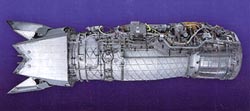
The F119-PW-100 has 40 percent fewer major parts than current engines. High-temperature Alloy C titanium is used in the compressor stator and the thrust-vectoring nozzle.
The aircraft began flight trials in May of 1997. Eventually it could be joined by additional development and preproduction models, for a five-year program of flight and ground testing. Whether this amazing aircraft goes into full production remains an open question.
The Pentagon has already slashed costs in the F-22 program by slowing its development and reducing the planned fleet size to 438 aircraft. Still, with each aircraft valued at somewhere between $70 million and a breathtaking $198 million, depending on how costs are computed, the program is undeniably expensive -perhaps prohibitively so. Earlier this year, Congress pulled the plug on production money, but still allocated more than $1 billion for continued development. So, as we go to press, the program continues to move forward.
The problem is that the airplane was supposed to trump the Soviets' next generation of weaponry. But now the Soviets are gone and Russia's military is barely able to put down internal conflicts. Many in Washington question the need to build the F-22 at all. The Pentagon also wants to develop the single-seat F/A-18E and the two-seat F/A-18F maritime strike attack Super Hornet, plus the Joint Strike Fighter. Budget cutters say there's not enough money to go around.
If the original F-22 survives and the current schedule remains intact, production could begin within a year, with the first unit becoming operational as early as 2004. The last aircraft would be delivered to the Air Force in 2012.
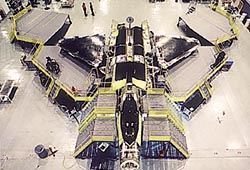
An F-22 during final assembly.
Constructed of 15 tons (its exact weight is classified) of titanium, aluminum, thermoplastic composites, fiberoptic lines, silicon, rubber and glass molded into a twin-tailed package, the jet measures 62 ft. 1 in. long, 44 ft. 6 in. wide, and 16 ft. 5 in. tall. It is the most sophisticated aircraft ever to have lifted off a runway.
To build this 21st century wonder, the Air Force drew upon all the knowledge gained in developing the F-117A stealth fighter, B-2 stealth bomber and even the SR-71 spy plane. Thanks to shaping and materials that deflect and absorb radar energy, the F-22 has a radar cross section orders of magnitude smaller than that of the F-15C. Its heat signature and electronic emissions have also been minimized. As a result, it can sneak up on other aircraft and ground installations-the enemy will remain unaware until the F-22's missiles, bombs or cannon fire announce its presence.
If the enemy does manage to lock onto an F-22, the next challenge is to catch it. The two Pratt & Whitney F119-PW-100 engines each develop some 35,000 pounds of thrust-more than any current fighter engine-and give the aerodynamically superclean airplane the ability to cruise at supersonic speeds, without afterburners. In air warfare, speed is survival and the F-22's "supersonic persistence" means it can penetrate deep into hostile territory and exit quickly, while producing low infrared emissions.
Should circumstances warrant, the pilot can also apply afterburners. Officially, the F-22 is a Mach 2-class airplane, but its true top-end speed is classified.
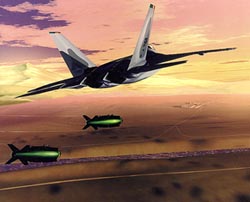
Smart bombs (above) and advanced composite materials (below) enable the F-22 to deliver an awesome punch.
The F-22 has an electronics suite that puts the capabilities envisioned by movie producers to shame. It includes sophisticated phased-array radar and an electronic warfare system that can detect any electronic emissions from the enemy. It also has a datalink to AWACS and other off-board sensors. To process the flood of incoming threat, navigation and aircraft systems data, the F-22 requires a computer that operates at an astounding 9 billion operations a second.
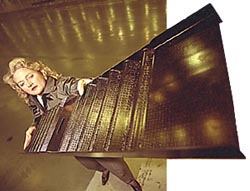 Since the aircraft is a single-pilot machine, great thought has gone into providing relevant information in easy-to-interpret displays. "The pilot is the center of our universe," one project manager tells POPULAR MECHANICS. The result is a cockpit with a wide-angle head-up display (HUD) and a suite of large, full-color, head-down liquid-crystal displays that dominate the panel.
Since the aircraft is a single-pilot machine, great thought has gone into providing relevant information in easy-to-interpret displays. "The pilot is the center of our universe," one project manager tells POPULAR MECHANICS. The result is a cockpit with a wide-angle head-up display (HUD) and a suite of large, full-color, head-down liquid-crystal displays that dominate the panel.
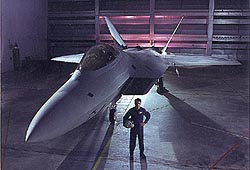 The main 8-in.-square center screen is the Situation Display and it gives the pilot an overview-often called a "God's eye" view-of the world around him. Data include his location and that of friendly aircraft. When enemy aircraft are detected, they appear on the screen along with data on their type, range, bearing, altitude, Mach number and closing speed. The on-board computer can automatically prioritize these targets on a shoot list. F-22 wingmen can transfer data between each other's screens, keeping them on top of the battle while keeping chatter to a minimum.
The main 8-in.-square center screen is the Situation Display and it gives the pilot an overview-often called a "God's eye" view-of the world around him. Data include his location and that of friendly aircraft. When enemy aircraft are detected, they appear on the screen along with data on their type, range, bearing, altitude, Mach number and closing speed. The on-board computer can automatically prioritize these targets on a shoot list. F-22 wingmen can transfer data between each other's screens, keeping them on top of the battle while keeping chatter to a minimum.
To the right is the Attack Display, which shows the enemy aircraft along with the range envelopes for the F-22's various missiles. Once a selected target comes within range of the F-22's missiles, a Shoot cue appears on the HUD and Attack Display. After missile launch, the display tracks the weapon until it hits or misses. If the aircraft drops from the screen, the pilot presses a button on his sidestick controller to acquire the next target.
The screen on the left is the Defense Display. It shows enemy surface-to-air missiles and aircraft, their radar and their missile-range envelopes. And it tracks enemy missiles once they are launched.
A fourth screen, positioned below the center primary display, provides aircraft systems data such as fuel status and checklists.
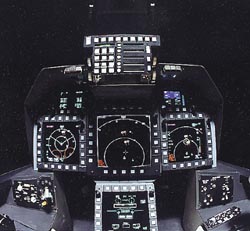
The F-22 cockpit presents the pilot with blocks of highly condensed information in easy-to-comprehend formats
Although the F-22 is supposed to avoid close-in air combat, when the time comes for a showdown the airplane should prove to be a mean dogfighter. Not only does it have a high thrust-to-weight ratio and smart avionics, but it also has two-dimensional thrust-vectoring nozzles, giving it low speed maneuverability, the key to close-in combat, unprecedented in a high-performance fighter. The thrust vectoring gives the aircraft high roll control even at angles of attack as high as 60s, enabling the pilot to point and shoot at very low speeds without fear of post-stall loss of control.
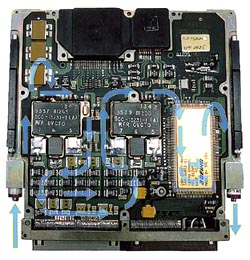
The aircraft's computing power rivals that of supercomputers.
The F-22 pilot has a formidable arsenal at his (or her) disposal. The basic air superiority configuration includes two short-range, heat-seeking Sidewinders and four medium-range radar-guided air-to-air missiles, plus a 20mm multibarrel cannon-all of which are housed in bays within the airframe's belly. The aircraft can also carry two 1000-pound bombs internally and be equipped with air-to-ground as well as radar-seeking missiles. Additional weapons are also planned. So, while the fighter may go undetected, its punch will not.
As the Air Force's primary air superiority fighter, the F-22 will be expected to rush to trouble anywhere in the world. Sitting under the spotlights that day in April 1997, revealed for the first time with its flawless skin, its gray-white presence at once shadowy and potent, t he F-22 Raptor seemed equal to the job.
"No one is going to want to challenge the F-22 in the air," said Lt. Col. Scott Anderson of the Air Combat Command. "And if they do, they will only do it once."